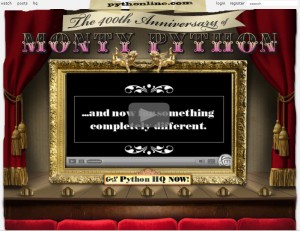In honor of the fortieth anniversary of Monty Python’s Flying Circus, here’s a slightly quirky post.
As a quick reminder for those who don’t remember, MPFC was a British television series (1969-1975) featuring comedy sketches so satirically wacky that many people, even today, can recite/re-enact some of the most popular segments. E.g., “Dead Parrot,” “Spam,” or “Confuse-a-Cat.” (Can’t resist a little Python nostalgia? Find all the sketch scripts here.)
What makes Monty Python relatively relevant to a column about Careers is that troupe-member John Cleese went on to found Video Arts, a company that makes/distributes training videos which “help you put across your learning messages in an entertaining and memorable way.” They combine humor with business expertise, in a style that might be called charming . . . or campy . . . or both. But see for yourself, with previews of several Recruiting/Interviewing videos.
Cleese also appears at companies and conferences around the world, amusing and inspiring audiences with a message about creativity in business. Which brings us to the second part of this topic: What makes potential employees really want to work for your company?
After monetary motives—ranging from really, really needing a job to really, really wanting a better compensation package—the main thing most people wonder is “will I be happy at Company X?” (Or at least not unhappy.) And one of the ways many prospects make that judgment is by a visit to the corporate Career site.
Hence the popularity of employee interviews extolling the company culture, day-in-the-life videos, and so on. But of course all that is staged, as everybody knows—not necessarily with a dishonest intent, just with a certain amount of inevitable manipulation. So direct messaging may have only a limited effect on savvy prospects.
Which leaves indirect messaging. The “look and feel” of the corporate Career site communicates at a deep level the way a company views life and work. Site visitors pick up that communication without necessarily even realizing it. They just go away with an impression that may be stronger than anything they actually read (or heard) in the direct messaging.
Yet as a rule, no one in the organization is tasked with asking some fundamental questions that would ensure effective delivery of the good-place-to-work message. Several of the needed considerations have been discussed in previous posts, but here’s a convenient recap and checklist:
- Do clear organization and intuitive navigation create a pleasant visitor experience?
- Are the colors and images not just “inoffensive” but actually interesting and memorable?
- Are there touches of humor and imagination?
- Does the site offer evidence (not just glib assurances) to demonstrate the company’s social engagement, sensitivity to work-life balance, commitment to diversity?
- Will visitors leave with something that persists—a communication link, helpful tips, useful insights, next steps?
If prospects don’t feel valued during their website visit, they are unlikely to assume the company will suddenly start to value them as candidates or as employees. First impressions!
Or as the Monty Python boys say: “A nod’s as good as a wink to a blind bat, eh?”
Cynthia Giles has followed a serpentine career path from academia to publishing to marketing and design to information technology and corporate communications. There’s plenty of detail about this journey at www.cynthiagiles.com, but briefly--the common theme has been ideas, and how to present them effectively. Along the way, she became an accidental expert on data warehousing and business intelligence, and for the past ten years she has combined corporate contracting with an independent consulting practice that focuses on marketing strategy for smaller businesses and non-profits.
Having spent quite a bit of time looking for work, and anywhere from two weeks to two years inside a wide variety of American companies—she has given much thought to what works (and what doesn’t) when it comes to creating a great employment fit.
